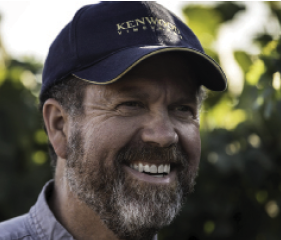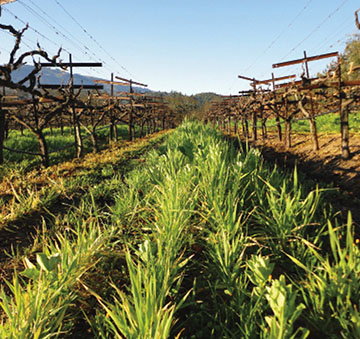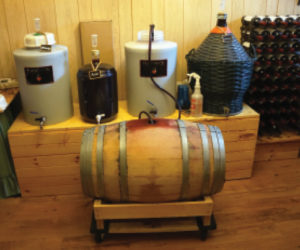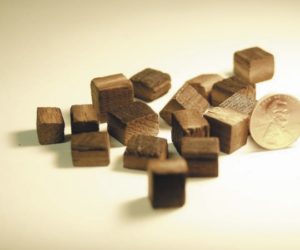
Pat Henderson:
Winemaker, author, and winemaking instructor — these are just a few of the hats that Pat Henderson wears day to day. While he has more than 35 vintages under his belt today, Pat started out as a hobby winemaker back in the early 1980s in Sonoma County, California. He took part in his first commercial harvest in 1983 and a career was born. He graduated from UC-Davis with a bachelor’s degree in viticulture and enology in 1985, and worked at several wineries including Hedges Cellars in Washington State and Valley of the Moon Winery in Glen Ellen, California before coming to work with Mike Lee, the original Winemaker at Kenwood Vineyards. Pat was promoted to Chief Winemaker at Kenwood in 2003, and is the co-author of the college textbook About Wine. He has also taught college-level winemaking courses at Santa Rosa Junior College since 1991, and is a member of The American Society of Enology and Viticulture as well as the Society of Wine Educators.
 I am lucky enough to both live and make wine in Sonoma County, California. For those of you that haven’t had a chance to visit, Sonoma lies about an hour’s drive north of the Golden Gate Bridge, sandwiched between Napa County to the east and the Pacific Ocean to the west. The proximity to the coast gives us a Mediterranean climate with mild winters and dry summers that have cool evenings and warm afternoons. Although we may not be quite as well known as our neighbor to the east, we grow more grapes and have a history of winemaking that goes back almost 200 years.
I am lucky enough to both live and make wine in Sonoma County, California. For those of you that haven’t had a chance to visit, Sonoma lies about an hour’s drive north of the Golden Gate Bridge, sandwiched between Napa County to the east and the Pacific Ocean to the west. The proximity to the coast gives us a Mediterranean climate with mild winters and dry summers that have cool evenings and warm afternoons. Although we may not be quite as well known as our neighbor to the east, we grow more grapes and have a history of winemaking that goes back almost 200 years.
My first harvest in Sonoma was back in 1983 when I took a few months off from getting my degree in winemaking to get some hands-on experience in the cellar. I was already making homemade wine and had worked a crush at a Napa winery the vintage before. One of things that impressed me right away (besides Sonoma’s natural beauty) was that the growers and vintners seemed extremely passionate about their craft and took it (but not themselves) very seriously. In other words, they prided themselves in making great wine and having a lot of fun while they were doing it. I’ve been smitten with the place ever since. Along the way, I’ve learned that there are lots of ways to make great wine, but some essential truths apply to all winemakers who want to make the best wine possible.
1. It’s all about the grapes
Any honest winemaker will tell you that the vineyard has a lot more to do with the quality of a wine than their skill as a winemaker does. One of the advantages I have for making wine in Sonoma is there are so many great vineyards with a variety of growing environments, or terroirs, to choose from. Chardonnay and Pinot Noir do best out by the coast where it is cool while varieties like Cabernet Sauvignon and Zinfandel do better in the warmer inland areas like the Dry Creek and Alexander Valleys.
The necessity of getting good grapes to make good wine applies to home winemakers just as much as it does to those of us who do it for a living. When I started making my own homemade wine when I was 19 I used second crop or overripe fruit that the grower could not sell; basically whatever grapes I could find for free. That worked OK because I was a rookie just learning the craft and besides I was a starving student so I did not have the money to buy good fruit anyway. A few years later I realized if I wanted to improve my wine I had to find some better grapes. Even though I had a lot of fun making wine with my friends it was a lot of work and there was no sense in going to all the effort if we didn’t love to drink what we made when we were finished. You will never make great wine without quality fruit — source the best grapes that you can afford, and if you grow grapes be diligent in maintaining your vineyard.
2. Be true to the fruit
Another lesson I learned early on is that it is best to not try to make a wine into something that it does not want to be. This happened when I made my first Pinot Noir; I knew that Pinot Noir has a lighter color and body than most red varieties and I thought if it got more extraction during fermentation the wine would have deeper color. So even though I scored some great grapes from an excellent Russian River vineyard, I managed to destroy them during fermentation by punching down the cap about 20 times a day! After the wine was pressed it was bitter and astringent and had very little fruit flavor. On top of that all that color I extracted was unstable, and after a couple of months of aging the wine looked like a rosé.
After that first disaster I started treating my Pinot Noirs a lot more gently and they started tasting a lot better. Before you crush a single grape, be sure you know what you’ve got in your grapes, and what kinds of wines your chosen varieties can make. Do your research and taste examples of wines made with those varieties. This way you can make more informed decisions in the winery when the grapes are harvested. This idea of making a wine what it wants to be applies to grape growing as well. If you really want to grow a Cabernet Sauvignon in your backyard but the climate where you live is better suited to cool weather varieties, you are probably better off buying some good Cabernet grapes from a region that is a warmer and planting something that likes cooler conditions
at home.
3. Keep it fresh
In addition to being a winemaker, I also have taught winemaking classes part time at our local community college. When I was teaching, I encouraged students to bring in any of their wines that they were having some difficulty with. Over the years I have tasted hundreds of these problem wines and more often than not the issue with them was oxidation.
Oxidation is a chemical reaction that can occur in wine when wine is exposed to air. Most commonly this occurs when wine is stored in a partially filled container such as a carboy, keg, or barrel that is not topped. While very small amounts of oxygen are essential to the proper development of red wines during aging, too much of it can lead to spoilage. Oxygen will react with aroma compounds robbing them of their flavor and lowering the varietal character of the wine. In its place it leaves a nutty Sherry-like smell that comes from acetaldehyde (CH3CHO), which is produced by the reaction of alcohol and oxygen.
Oxygen affects the color of wine as well, giving a white wine a golden color and causing a red wine to have an orangey-brown tint. Too much exposure to oxygen will also encourage the growth of spoilage microbes such as vinegar bacteria (Acetobacter) and surface film yeast.
There is a simple way to avoid these problems: KEEP THINGS TOPPED UP! I hate to have to go all caps on you but I cannot overemphasize how important this is. At Kenwood, even though we have access to inert gasses like nitrogen and argon to purge headspace as well as oxygen meters and trained staff to use them, we do our best to keep all our tanks topped. We know if things are filled to the brim there will be a much lower potential for trouble. I should mention that headspace is not an issue in actively fermenting vessels because the carbon dioxide being produced by the yeast will drive out all the air in the headspace.
How you store your wine makes a big difference as well. In wines that are being aged in barrels, alcohol and water will slowly evaporate through the wood creating headspace or ullage. This is why wines being aged in wooden containers must be topped periodically. If the cellar that you have your wine is a little warm or has low humidity, the rate of evaporation is increased and the barrels must be topped more frequently.
One reason headspace is a common problem for home winemakers is they often only have a few containers of wine in their cellar and may not have many options available when they are looking for some wine to use for topping. Rather than blend in another wine or break down a keg into a lot of smaller bottles they just say to themselves, “oh, a little air won’t hurt.” I am of the opinion that you should top your carboys and kegs whenever you open them to taste or grab a sample. For barrels, I think that topping every 6 to 8 weeks is a good idea even if the bung has not been removed over that time. If you don’t have the exact same wine to top with you can always use a little wine from a previous vintage or use a little store-bought wine.
Another important tool for preserving you wine’s flavor is the proper use of sulfur dioxide (SO2). SO2 keeps wine fresh by discouraging the growth of spoilage microbes and it also works as a weak antioxidant. SO2 also will bind with acetaldehyde so a wine that has been slightly oxidized will get some of its original aroma back after a proper addition. So how much should you add? Well, that depends on a number of factors but most especially it depends on the pH. SO2 is ten times more effective at pH 3 than it is at pH 4.
How much SO2 to add and when is a complicated subject; if you would like some more information I dove in deep on the subject in a two-part WineMaker article back in 2008 (August-September and October-November issues). One final point that I should mention about SO2 is that it not only inhibits spoilage microbes it also discourages malolactic bacteria so any additions should be very limited until after malolactic fermentation (MLF) is completely finished.
4. Make sure your wine is ready for bottling
After a wine has been bottled there is not very much you can do to change the flavor or correct problems that develop. So you need to be sure that the wine is clarified and stable before you put a cork in it. Clarification can be done by fining, filtration, or by just giving it a little time and allowing it to settle and then racking it clean. Stabilization insures that a clean wine will stay so. White wines might need a little bentonite to remove excess protein that could make the wine cloudy over time. This is referred to as making the wine heat stable because the process of testing for protein stability involves heating the wine.
Both red and white wines should also be cold stable before they are bottled. This is where the wine is chilled so that excess potassium bitartrate, or cream of tartar, will fall out of solution and crystallize in the barrel or keg it is being stored in prior to bottling. To check if your wine is cold stable, just put it in the refrigerator for about a week and see if any crystals form.
In addition to being heat and cold stable, make sure your wine is microbially stable before you bottle it. Fermentation in the bottle of any kind is never good unless you are making sparkling wine or beer. To avoid this, make certain both the alcoholic fermentation by yeast and the malolactic fermentation by bacteria is completely finished before bottling. Once they are both complete, there is no longer any food for the microbes to consume, so you don’t have to worry about them growing after bottling and making the wine cloudy, effervescent, or the corks pushing out.
Another mistake novice winemakers make is assuming that MLF is finished just because it looks like it is done. After MLF has been going for a few months it starts to slow down, the wine settles out clean and there are no more bubbles coming off the wine. The wine might be finished with MLF or maybe the cool winter weather has just temporarily suspended fermentation until things warm up again in the summer. There is no way to tell unless you test to see if all of the malic acid is gone. I made this mistake with my first Cabernet Sauvignon. It tasted pretty good until the bottled wine started fermenting and pushing corks the next August.
But what if you want to make a wine that has a little sweetness or has not completed MLF? This can be done but now since there is some residual sugar or malic acid in the wine that the microbes can grow on you need to remove the microbes by sterile filtration followed by sterile bottling, or alternatively by adding a preservative to prevent their growth. Sorbic acid (sorbate) can be used to prevent yeast growth and fumaric acid will prevent MLF. Generally if it is possible, I think that filtration is the better option. An SO2 addition before bottling is also a good idea whether or not there is a risk of further fermentation.
Final Thoughts
I made wine in my garage for about 10 years before things got a little too busy during vintage with my day job to keep it up. Even though I made wine every day at work I always loved making it at home as well. When you are making wine at home it is all about crafting something that you like to drink and you do not have to worry about selling it, government regulations, or paperwork; it is just about having a good time. Whenever there was some task to be done like bottling or crush we always made sure there was plenty of food and drink available so it really turned into more of a party than anything else. As a matter of fact, maybe that is the best tip from Sonoma that I can give; get some grapes, get some friends, make some wine and be sure to have some fun while you are doing it.







